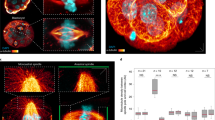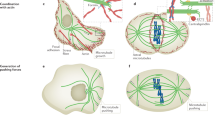Abstract
Proper positioning of the cell division plane during mitosis is essential for determining the size and position of the two daughter cells—a critical step during development and cell differentiation1. A bipolar microtubule array has been proposed to be a minimum requirement for furrow positioning in mammalian cells, with furrows forming at the site of microtubule plus-end overlap between the spindle poles2,4,4. Observations in other species have suggested, however, that this may not be true5,6. Here we show, by inducing mammalian tissue cells with monopolar spindles to enter anaphase7,8, that furrow formation in cultured mammalian cells does not require a bipolar spindle. Unexpectedly, cytokinesis occurs at high frequency in monopolar cells. Division always occurs at a cortical position distal to the chromosomes. Analysis of microtubules during cytokinesis in cells with monopolar and bipolar spindles shows that a subpopulation of stable microtubules extends past chromosomes and binds to the cell cortex at the site of furrow formation. Our data are consistent with a model in which chromosomes supply microtubules with factors that promote microtubule stability and furrowing.
This is a preview of subscription content, access via your institution
Access options
Subscribe to this journal
Receive 51 print issues and online access
$199.00 per year
only $3.90 per issue
Buy this article
- Purchase on Springer Link
- Instant access to full article PDF
Prices may be subject to local taxes which are calculated during checkout




Similar content being viewed by others
References
Rappaport, R. Cytokinesis in Animal Cells (Cambridge Univ, Cambridge, UK, 1997)
Harris, A. K. & Gewalt, S. L. Simulation testing of mechanisms for inducing the formation of the contractile ring in cytokinesis. J. Cell Biol. 109, 2215–2223 (1989)
White, J. G. & Borisy, G. G. On the mechanism of cytokinesis in animal cells. J. Theor. Biol. 101, 289–316 (1983)
Mandato, C. A., Benink, H. A. & Bement, W. M. Microtubule–actomyosin interactions in cortical flow and cytokinesis. Cell Motil. Cytoskeleton 45, 87–92 (2000)
Wolf, N., Hirsh, D. & McIntosh, J. R. Spermatogenesis in males of the free-living nematode, Caenorhabditis elegans. J. Ultrastruct. Res. 63, 155–169 (1978)
Rappaport, R. Experiments concerning the cleavage stimulus in sand dollar eggs. J. Exp. Zool. 148, 81–89 (1961)
Mayer, T. U. et al. Small molecule inhibitor of mitotic spindle bipolarity identified in a phenotype-based screen. Science 286, 971–974 (1999)
Kapoor, T. M., Mayer, T. U., Coughlin, M. L. & Mitchison, T. J. Probing spindle assembly mechanisms with monastrol, a small molecule inhibitor of the mitotic kinesin, Eg5. J. Cell Biol. 150, 975–988 (2000)
Canman, J. C., Hoffman, D. B. & Salmon, E. D. The role of pre- and post-anaphase microtubules in the cytokinesis phase of the cell cycle. Curr. Biol. 10, 611–614 (2000)
Gorbsky, G. J., Chen, R. H. & Murray, A. W. Microinjection of antibody to Mad2 protein into mammalian cells in mitosis induces premature anaphase. J. Cell Biol. 141, 1193–1205 (1998)
Canman, J. C., Salmon, E. D. & Fang, G. Inducing precocious anaphase in cultured mammalian cells. Cell Motil. Cytoskeleton 52, 61–65 (2002)
Canman, J. C. et al. Anaphase onset does not require the microtubule-dependent depletion of kinetochore and centromere-binding proteins. J. Cell Sci. 115, 3787–3795 (2002)
Wheatley, S. P., Kandels-Lewis, S. E., Adams, R. R., Ainsztein, A. M. & Earnshaw, W. C. INCENP binds directly to tubulin and requires dynamic microtubules to target to the cleavage furrow. Exp. Cell Res. 262, 122–127 (2001)
Murata-Hori, M. & Wang, Y. L. Both midzone and astral microtubules are involved in the delivery of cytokinesis signals: insights from the mobility of aurora B. J. Cell Biol. 159, 45–53 (2002)
Adams, R. R., Carmena, M. & Earnshaw, W. C. Chromosomal passengers and the (aurora) ABCs of mitosis. Trends Cell Biol. 11, 49–54 (2001)
Mackay, A. M., Ainsztein, A. M., Eckley, D. M. & Earnshaw, W. C. A dominant mutant of inner centromere protein (INCENP), a chromosomal protein, disrupts prometaphase congression and cytokinesis. J. Cell Biol. 140, 991–1002 (1998)
Shannon, K. B., Canman, J. C. & Salmon, E. D. Mad2 and BubR1 function in a single checkpoint pathway that responds to a loss of tension. Mol. Biol. Cell 13, 3706–3719 (2002)
Kurz, T. et al. Cytoskeletal regulation by the Nedd8 ubiquitin-like protein modification pathway. Science 295, 1294–1298 (2002)
Dechant, R. & Glotzer, M. Centrosome separation and central spindle assembly act in redundant pathways that regulate microtubule density and trigger cleavage furrow formation. Dev. Cell 4, 333–344 (2003)
Asnes, C. F. & Schroeder, T. E. Cell cleavage. Ultrastructural evidence against equatorial stimulation by aster microtubules. Exp. Cell Res. 122, 327–338 (1979)
Wittmann, T. & Waterman-Storer, C. M. Cell motility: can Rho GTPases and microtubules point the way? J. Cell Sci. 114, 3795–3803 (2001)
Kubai, D. F. Meiosis in Sciara coprophila: structure of the spindle and chromosome behavior during the first meiotic division. J. Cell Biol. 93, 655–669 (1982)
Foe, V. E., Field, C. M. & Odell, G. M. Microtubules and mitotic cycle phase modulate spatiotemporal distributions of F-actin and myosin II in Drosophila syncytial blastoderm embryos. Development 127, 1767–1787 (2000)
Radley, J. M. & Scurfield, G. The mechanism of platelet release. Blood 56, 996–999 (1980)
Howell, B. J., Hoffman, D. B., Fang, G., Murray, A. W. & Salmon, E. D. Visualization of Mad2 dynamics at kinetochores, along spindle fibres, and at spindle poles in living cells. J. Cell Biol. 150, 1233–1250 (2000)
Acknowledgements
We thank B. Bowerman, J. Sekelsky, N. Salmon, A. Harris and K. Bloom for comments on the manuscript; C. Waterman-Storer for discussions; the Cell Division Group at the Marine Biological Laboratory in Woods Hole; and B. Howell, D. Cimini, J. DeLuca, K. Shannon, C. Pearson, B. Moree and all members of the Salmon laboratory for support.
Author information
Authors and Affiliations
Corresponding author
Ethics declarations
Competing interests
The authors declare that they have no competing financial interests.
Rights and permissions
About this article
Cite this article
Canman, J., Cameron, L., Maddox, P. et al. Determining the position of the cell division plane. Nature 424, 1074–1078 (2003). https://doi.org/10.1038/nature01860
Received:
Accepted:
Published:
Issue Date:
DOI: https://doi.org/10.1038/nature01860
This article is cited by
-
Inhibition of polar actin assembly by astral microtubules is required for cytokinesis
Nature Communications (2021)
-
Help or hindrance: how do microtubule-based forces contribute to genome damage and repair?
Current Genetics (2020)
-
Mitsui-7, heat-treated, and nitrogen-doped multi-walled carbon nanotubes elicit genotoxicity in human lung epithelial cells
Particle and Fibre Toxicology (2019)
-
IFT proteins spatially control the geometry of cleavage furrow ingression and lumen positioning
Nature Communications (2017)
-
Coupling changes in cell shape to chromosome segregation
Nature Reviews Molecular Cell Biology (2016)
Comments
By submitting a comment you agree to abide by our Terms and Community Guidelines. If you find something abusive or that does not comply with our terms or guidelines please flag it as inappropriate.



